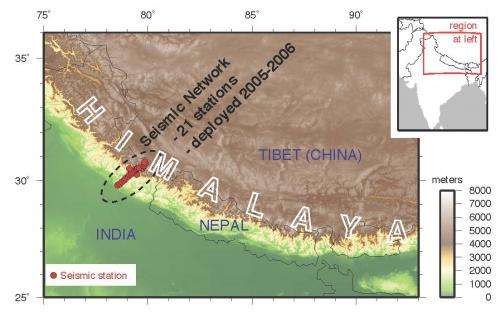Himalayas and Pacific Northwest could experience major earthquakes, geophysicists say

(Phys.org)—Research by Stanford scientists focuses on geologic features and activity in the Himalayas and Pacific Northwest that could mean those areas are primed for major earthquakes.
Stanford geophysicists are well represented at the meeting of the American Geophysical Union this week in San Francisco. Included among the many presentations will be several studies that relate to predicting – and preparing for – major earthquakes in the Himalaya Mountains and the Pacific Northwest.
The AGU Fall Meeting is the largest worldwide conference in the geophysical sciences, attracting more than 20,000 Earth and space scientists, educators, students, and other leaders. This 45th annual fall meeting is taking place through Dec. 7 at the Moscone Convention Center in San Francisco.
A big one in the Himalayas
The Himalayan range was formed, and remains currently active, due to the collision of the Indian and Asian continental plates. Scientists have known for some time that India is subducting under Asia, and have recently begun studying the complexity of this volatile collision zone in greater detail, particularly the fault that separates the two plates, the Main Himalayan Thrust (MHT).
Previous observations had indicated a relatively uniform fault plane that dipped a few degrees to the north. To produce a clearer picture of the fault, Warren Caldwell, a geophysics doctoral student at Stanford, has analyzed seismic data from 20 seismometers deployed for two years across the Himalayas by colleagues at the National Geophysical Research Institute of India.
The data imaged a thrust dipping a gentle two to four degrees northward, as has been previously inferred, but also revealed a segment of the thrust that dips more steeply (15 degrees downward) for 20 kilometers. Such a ramp has been postulated to be a nucleation point for massive earthquakes in the Himalaya.
Although Caldwell emphasized that his research focuses on imaging the fault, not on predicting earthquakes, he noted that the MHT has historically been responsible for a magnitude 8 to 9 earthquake every several hundred years.
"What we're observing doesn't bear on where we are in the earthquake cycle, but it has implications in predicting earthquake magnitude," Caldwell said. "From our imaging, the ramp location is a bit farther north than has been previously observed, which would create a larger rupture width and a larger magnitude earthquake."
Caldwell will present a poster detailing the research on Tuesday, Dec. 4, from 1:40 p.m. to 6 p.m. in Moscone South, Halls A-C.
Caldwell's adviser, geophysics Professor Simon Klemperer, added that recent detections of magma and water around the MHT indicate which segments of the thrust will rupture during an earthquake.
"We think that the big thrust vault will probably rupture southward to the Earth's surface, but we don't expect significant rupture north of there," Klemperer said. The findings are important for creating risk assessments and disaster plans for the heavily populated cities in the region.
Klemperer spoke about the evolution of geophysical studies of the Himalayas today (Dec. 3) from 1:40 p.m. to 3:40 p.m. in Moscone South.
Measuring small tremors in the Pacific Northwest
The Cascadia subduction zone, which stretches from northern California to Vancouver Island, has not experienced a major seismic event since it ruptured in 1700, an 8.7
More information: Geophysics Professor Paul Segall will present this work on Thursday (Dec. 6) from 10:20 a.m. to 12:20 p.m. in Moscone South.
Provided by Stanford University















